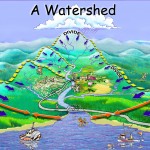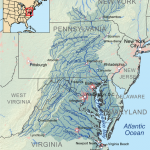The Chesapeake Bay Watershed
What exactly is a watershed?
A watershed is an area of land that water flows across or drains from, into rivers and streams and eventually ending in one larger body of water.
The Chesapeake Bays watershed is often thought of as only in Maryland, but five other states (New York, Pennsylvania, Delaware, West Virginia, Virginia), and the District of Columbia are also a part of this watershed. The borders of our watershed stretch as far north as the Finger Lakes of New York and as far south as Norfolk, Virginia.
Whatever happens to the watershed happens to the Bay.
Essentially, whatever is put on the land or in the streams and rivers within the borders of the watershed will eventually end up in the Bay. The easiest way to understand how it works is if you imagine that all the land in the watershed is at a higher elevation then the Bay itself. Then imagine someone sprinkling pink food coloring on different parts of the land. We know that water flows downhill so when it rains the water will fall on the land and flow downhill carrying with it the food coloring. The end result would be that the Bay would turn pink! We of course aren’t going to sprinkle food coloring all over the watershed but there are other much more hazardous things that we put on the land everyday. Here are some examples:
- Motor oil leaking from cars.
- Pet and agricultural animal waste.
- Chemicals used in industrial manufacturing.
- Raw sewage from faulty septic tanks and aging sewage treatment plants.
- Fertilizers, herbicides and insecticides used on agricultural fields.
 Example: if a farmer in Northern Pennsylvania uses excessive amounts of fertilizer on his crops, the excess nitrogen from the fertilizer will be washed from his fields when it rains and it will then enter a nearby stream and then travel down to an adjoining river where it will be carried to the Bay. Once that excess nitrogen enters the Bay it will create algae blooms which lead to dead zones in the water and are responsible for massive fish kills and many other environmental issues.
Example: if a farmer in Northern Pennsylvania uses excessive amounts of fertilizer on his crops, the excess nitrogen from the fertilizer will be washed from his fields when it rains and it will then enter a nearby stream and then travel down to an adjoining river where it will be carried to the Bay. Once that excess nitrogen enters the Bay it will create algae blooms which lead to dead zones in the water and are responsible for massive fish kills and many other environmental issues.
Missy Lauterbach – Naturalist/Adventure Guide – Terrapin Adventures

